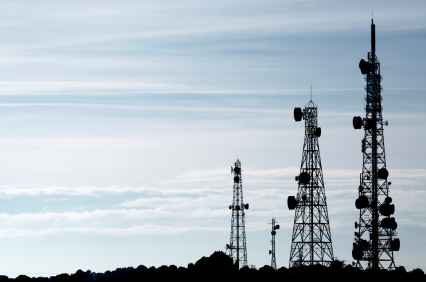The Evolution to 5G
By: Mike Wolfe

5G wireless technology is coming rapidly, but mobile network operators (MNOs) have billions invested in 4G networks, and those networks will, in many cases, form the basis of 5G networks. So how do 4G networks evolve to support 5G? We know that 5G will deliver about ten times the throughput of 4G, and that it will likely use higher frequencies, but how do we get from 4G to 5G? In this article, we’ll look at the fundamental changes that will occur during the transition from 4G to 5G.
Network Densification
![]() If 5G is really going to deliver speeds that are ten times or more faster than 4G, simple physics dictates that the best way to drive higher network capacity within a given
spectrum footprint is to have more base stations within a given area. MNOs began densifying their networks with 3G and 4G technologies by increasing sectorization and adding distributed antenna
systems (DAS) and small cells. The ongoing densification effort involves macro sites, indoor areas, metro cells and small cells, and it’s crucial that the MNOs be able to acquire new sites for
this infrastructure.
If 5G is really going to deliver speeds that are ten times or more faster than 4G, simple physics dictates that the best way to drive higher network capacity within a given
spectrum footprint is to have more base stations within a given area. MNOs began densifying their networks with 3G and 4G technologies by increasing sectorization and adding distributed antenna
systems (DAS) and small cells. The ongoing densification effort involves macro sites, indoor areas, metro cells and small cells, and it’s crucial that the MNOs be able to acquire new sites for
this infrastructure.
Site Acquisition
Site acquisition has long been a problem for operators, and it is an issue that will persist as operators look for even more space on which to build and implement their 5G networks. There has been a lot of debate about how providers can get better access to sites. It is imperative that all internal and external mobile network stakeholders work together in order to construct an effective blueprint that makes rolling out 5G network sites a more streamlined process. Efforts to streamline zoning and standardize leasing costs are welcome reforms that will help speed deployments.
CloudSmartz Whitepapers
- Redefining Telecom
- OpenKilda: Lessons Learned
- Telecom in the Age of the Cloud
- DevOps-as-a-Service
- Real-Time IT for CSPs
About CloudSmartz
CloudSmartz is a challenger in the industry for Lifecycle Service and Customer Orchestration, enabling digital transformation for Communications Service Providers (CSPs) around the
world. We are considered an orchestrator-of-orchestrators – we act as an innovation enabler on the service-provider and customer-facing layer, which helps CSPs to operationalize
and monetize their back-end technology infrastructure investments through our innovative microservice architecture. Our mission is to help transform forward-thinking CSPs into
next-generation, on-demand, customer-centric service providers. We seek out dynamic disruptive leaders who want to reimagine, innovate, and reinvent. Gartner has recently named
CloudSmartz as a 2018 Cool Vendor In Communications Service Provider Business Operations – and 451 Research shares that our solutions bridge the gap between the carrier's new
virtualized SDN/NFV network and the carrier's OSS/BSS systems so the carrier can move from deploying a network to deploying services and generating revenue. Our global offices
around the worlds are proud to have been recently awarded, “Most Innovative Technology Provider” & “Innovations in Aggregation” by Pipeline Magazine – and as of 2019, Inc. 5000
named CloudSmartz one of America's Fastest-Growing Privately-Held Companies for Four Consecutive Years in a row (2016, 2017, 2018, 2019).
Spectrum
Operators will also densify their networks by adding more bandwidth and spectrum. One approach to deploying 5G will be repurposing low-band spectrum (such as 850Mhz) as a coverage layer for 5G. 5G will also be deployed in the 600 MHz band in the US, which has superior propagation characteristics and building penetration. To support higher throughputs, the operators will utilize mid-band and high-band spectrum.
The 2.6 and 3.5 GHz bands are emerging as global 5G bands, which will be used for both indoor and outdoor, fixed and mobile applications. 3.5 GHz is currently available in all regions and has decent propagation characteristics with a good amount of bandwidth. It likely will be a global roaming band for 5G.
Higher bands in millimeter waves above 6 GHz will also be used, but as these higher frequencies don’t reach very far, they will largely be deployed on small cells and other local antennas that are close to users. Given the limited availability of clear, unused spectrum in the traditional cellular bands (400Mhz to 2.5GHz), new spectrum bands need to be brought into the mix and lightly used spectrum must also be considered.
One of the greatest barriers to the rollout and adoption of 4G services was the ability of governments to quickly free up spectrum. When it comes to 5G, this barrier cannot exist if the concept of a ubiquitous 5G network is to become reality. Regardless of regulators’ ability to allocate new spectrum, spectrum will always be a finite and costly resource for mobile network operators. Therefore, technologies such as massive MIMO antenna architectures (which derive more capacity from a given amount of spectrum) will also be critical.




















